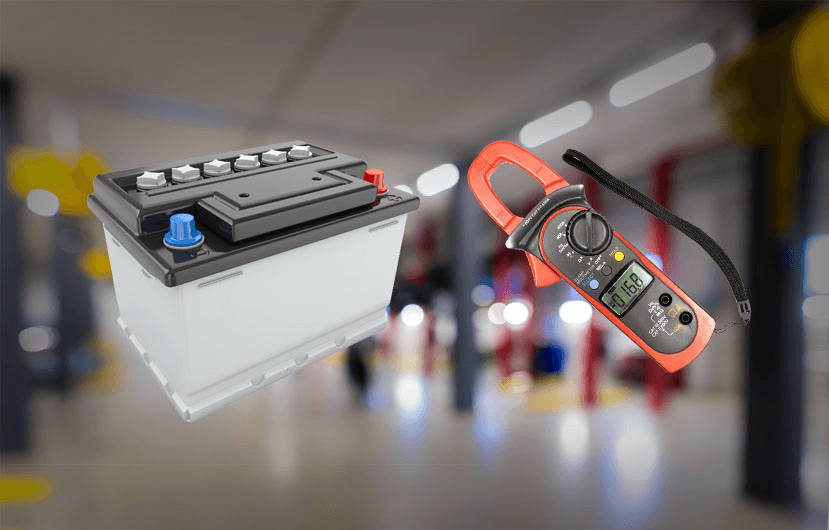
Purchasing a new battery for your car may not always be as easy as it sounds. You need to ensure that you have made the right choice and one way to do this is to ascertain the battery’s overall capacity which can be done by turning CCA to Ah/Amp-hours.
To accomplish the above objective requires you to be aware of the potential capacity of the battery that you choose. There are, therefore, two main units that are used to determine this capacity, namely the Cold Cranking Amps (CCA) and the Ampere Hours (Ah/Amp). The former denotes the current that a battery can supply in low temperatures.
While the latter is a measurement tool, to use to understand how many amps you can discharge from a battery over an estimated amount of time.
Converting CCA to Amp Hours
Unfortunately, there is no direct relationship between CCA and Amp-hours. Therefore, these units can’t be directly converted to attain an exact value. As a rule of thumb, the value can be retrieved, though it may not offer a precise measurement of the battery in question. The basis of this rule of thumb involves dividing the value in question by 7.25.
For example, you have a battery with a 1450 CCA measurement, dividing this figure by 7.25 will give you a value of 200 Ah/Amp, so if you want to learn how to convert Amp-hours to CCA, then you simply have to reverse the process.
This means multiplying your Ah/Amp value by 7.25. Besides, knowing your particular rate of use as well as the voltage levels involved can help you make a better decision when dealing with these units. Batteries with a 1450 CCA/200 Ah/Amp, for example, can last for up to 25 hours while producing a voltage of 8 amps. This figure will then drop to 20 hours if the voltage applied is 10 amps.
Gaining further knowledge on these aspects can better equip you to carry out such calculations.
Ampere Hours
Amperes are used to measure the current and flow of electrons within a conductor. One ampere represents a single unit of electric charge that passes through every part of a conducting item in a second. Many battery measurements are portrayed via the use of ampere-hours. The unit, therefore, represents the threshold of the battery’s operation. In simple terms, Ampere hours can be used to determine how long a specific battery can last before needing to be recharged.
Cold Cranking Amps
Cold Cranking Amps are mainly used to determine a battery’s ability to start your engine at various temperatures. Knowing this capacity can help you better choose a battery according to the particular conditions of your environment. If you live in a specifically cold region, for example, then you will need to ensure that you choose a battery that will not give you trouble when the temperature drops to a significant level.
It should be noted that CCAs cannot be used to determine a battery’s overall capacity. To achieve this, you will need a CCA to Amp hour’s calculator. Batteries with higher capacity and power will exhibit better CCA values as compared to weaker alternatives.
Battery Capacity in Relation to Ampere Hours
As mentioned earlier, Ampere hours are used to determine the potential capacity of a particular battery. However, it should be noted that this element also depends on the dynamics of the environment involved with the battery. In short, the particular conditions a battery is placed in plays a role in the overall capacity that can be enjoyed.
Amp-hours are usually indicated on a battery in a manner that allows you to identify its potential capacity. A battery that has been marked as having 200Ah @ 25Hr means that it can offer a constant supply of current for about 25 hours, going at a rate of 8 amps. Gaining such information can help you choose a longer-lasting battery in relation to capacity.
The capacity of a battery reduces with continued use. No matter the specific number of Amp-hours indicated, the rate of discharge will increase in a non-linear manner over time. Accountings for this dip in performance can therefore, help you calculate a more accurate value in relation to a battery’s capacity.
How to use a Battery Multimeter to Calculate CCA
Determining the potential CCA of your battery can be easily achieved using a battery multimeter that contains a CCA reading function. This device can be easily acquired online or in local shops around your area. You should be careful to ensure that the particular multimeter you choose contains a CCA reading function, as not all models possess the same abilities.
You `will need a pair of rubber work gloves for protection from potential contact with battery acid and electrical shocks. The first step involves locating your car’s battery, which should be simple enough to do. Using a socket wrench, loosen the bolts on the positive and negative terminals of the battery. Should there be any grime on the terminals, you can clean this using baking soda and some water. It’s crucial to ensure that the terminals are adequately dry before moving to the next stage.
Once this is done, you’ll need to place the multimeter on the terminals, with the positive and negative sides of the device correlating with the points on the battery. Afterward, tighten the terminal’s bolts to encourage a secure connection. Next, turn on the multimeter and adjust the settings to the CCA reading function.
Finally, start your car’s engine and let it run for 30 seconds. After this time period has elapsed, you can turn off the engine and head back to the multimeter to check the readings. The results are usually portrayed in a graph depicting a peak and average reading.
Taking Care of your Battery
It’s essential to ensure that you treat your battery in an appropriate manner if you are to enhance its shelf life. Ensuring that they are recharged after they discharge, for example, is crucial in its maintenance. Discharging a battery beyond its expected capacity can also enhance the deterioration process. You should also make sure that your battery is properly secure whenever it’s mounted, as well as keep the case clean at all times. When charging or jump-starting your vehicle, you should be careful not to tilt the battery in the process.
Charging your batteries when they are frozen is also something that should be avoided. Should you find yourself facing such circumstances, buying a new battery is the best course of action to take. Trying to charge a frozen battery can represent a dangerous task, as they will most likely explode during the process.
Battery basics
A car battery has the ability to deliver up to 300amps if short-circuited, which will lead to its destruction because of the extreme heating and the intense outgassing. In such a situation the plates would overheat and warp and the battery will then be destroyed. So, to avoid the above don’t crank the starter motor.
Also whenever you have finished charging your battery, care should be taken in the mode of transportation and how it is hooked up, because if by any chance the terminals short, you will be exposed to danger. Lastly, whenever you are dealing with a car battery there are some three important facts that you should have at your fingertips.
The first one is your batteries amp/hour rating, its voltage and chemistry. The latter is used to determine the voltage of a cell, and the number of cells is used to determine the voltage of the battery. The above information will come in handy whenever you want to use your battery for other purposes like jumpstarting or during charging and the overall time needed for full charge.
Frequently Asked Questions
- How do I determine the number of amp-hours in my battery?
To determine the above you would have to multiply your batteries’ current amp by two to get your batteries true AH rating.
- How many CAA should a car battery have?
A battery should have at least one cold-cranking amp for every cubic inch of the engine’s displacement and if its diesel, then you need two cold-cranking amps and that is with regard to the standard recommendations.
- What is the difference between Cold Cranking Amps and Amp Hours?
As discussed earlier CCA and Amp-hours do not have any kind of relation, the former is indicative of how much current the battery can supply in 30 seconds. Whereas, Amp-Hours is the amount of time that the battery can output a fixed current.
- How can I protect my car battery from a phantom drain?
People who live in cold areas will very much want to protect their car batteries from discharge if they rarely drive them. There are thus two methods that you can use to accomplish this, one is by getting a mechanical disconnect switch that you can use to disconnect the negative cable in the battery.
You could also conserve your battery by connecting it to a battery minder, the device keeps the battery condition in check and whenever it gets low, it gives it a gradual charge to keep it in the recommended levels.
Which Car Speaker Brand is More Efficient in Converting CCA to Ah/Amp Hours?
When comparing infinity kappa vs jbl gto629 car speakers, it’s important to consider their efficiency in converting cold cranking amperes (CCA) to ampere-hours (Ah). While both brands offer high-quality speakers, each may differ in terms of power conversion efficiency. Researching user reviews and expert opinions can provide valuable insights in determining which brand excels in converting CCA to Ah, ultimately helping you make an informed decision.
Conclusion
People who live in cold areas are more than conversant with CCA, the reason being that the battery could very likely be unable to start the engine when not used for long, while in the cold areas. The situation is however opposite for those who live in warmer areas, as their batteries remain stable thus experience no problems when starting their cars. And since battery starting power deteriorates with time, you should make it your mission to get one with a higher starting power.
